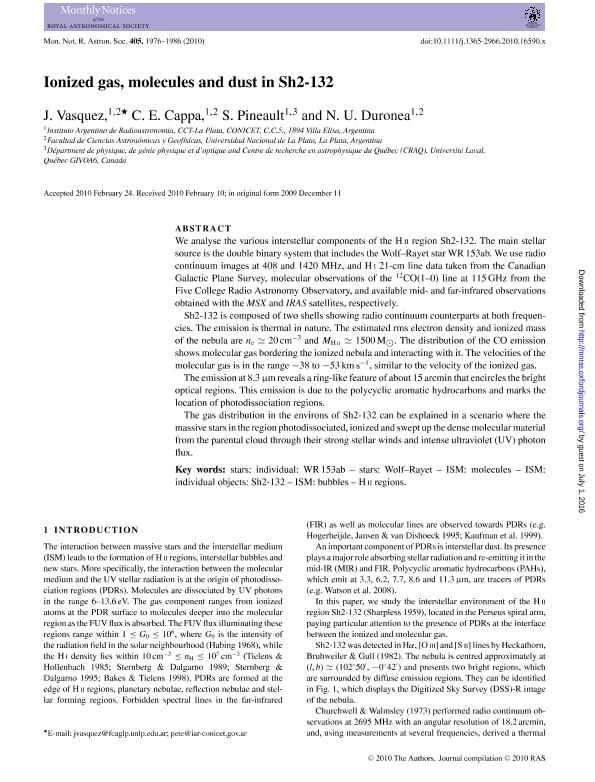Artículo
Ionized gas, molecules and dust in Sh2-132
Fecha de publicación:
07/2010
Editorial:
Wiley
Revista:
Monthly Notices of the Royal Astronomical Society
ISSN:
0035-8711
Idioma:
Inglés
Tipo de recurso:
Artículo publicado
Clasificación temática:
Resumen
We analyse the various interstellar components of the H II region Sh2-132. The main stellar source is the double binary system that includes the Wolf–Rayet star WR 153ab. We use radio continuum images at 408 and 1420 MHz, and H I 21-cm line data taken from the Canadian Galactic Plane Survey, molecular observations of the 12CO(1–0) line at 115 GHz from the Five College Radio Astronomy Observatory, and available mid- and far-infrared observations obtained with the MSX and IRAS satellites, respectively. Sh2-132 is composed of two shells showing radio continuum counterparts at both frequencies. The emission is thermal in nature. The estimated rms electron density and ionized mass of the nebula are ne≃ 20 cm−3 and Graphic. The distribution of the CO emission shows molecular gas bordering the ionized nebula and interacting with it. The velocities of the molecular gas is in the range −38 to −53 km s−1, similar to the velocity of the ionized gas. The emission at 8.3 μm reveals a ring-like feature of about 15 arcmin that encircles the bright optical regions. This emission is due to the polycyclic aromatic hydrocarbons and marks the location of photodissociation regions. The gas distribution in the environs of Sh2-132 can be explained in a scenario where the massive stars in the region photodissociated, ionized and swept up the dense molecular material from the parental cloud through their strong stellar winds and intense ultraviolet (UV) photon flux.
Archivos asociados
Licencia
Identificadores
Colecciones
Articulos(IAR)
Articulos de INST.ARG.DE RADIOASTRONOMIA (I)
Articulos de INST.ARG.DE RADIOASTRONOMIA (I)
Citación
Vasquez, Javier; Cappa, Cristina Elisabeth; Pineault, Serge; Duronea, Nicolas Urbano; Ionized gas, molecules and dust in Sh2-132; Wiley; Monthly Notices of the Royal Astronomical Society; 405; 3; 7-2010; 1976-1986
Compartir
Altmétricas




